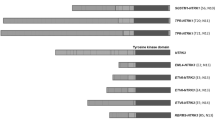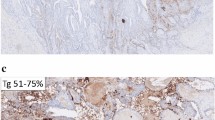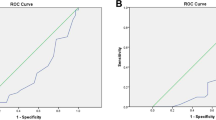Abstract
Topoisomerase II (topo II) is an enzyme that affects replication, transcription, and chromosome segregation. It serves as a target for several useful antichemotherapeutic agents, such as etoposide (VP-16) and teniposide (VM26). Monoclonal antibody topo IIα (Clone JH2.7; Neomarkers, Union City, CA) specifically identifies the alpha isoform of topo II. Using this antibody in an immunohistochemical analysis, we studied differential expression of topo II in a variety of thyroid lesions. The topo II labeling index is defined as the number of topo II staining positive nuclei divided by the total number of tumor cells counted multiplied by 100. An average of 1000 cells were counted in each case. The average labeling indexes for anaplastic carcinoma (7.8), tall cell variant of papillary carcinoma (4.8), follicular carcinoma (2.6), Hürthle cell carcinoma (3.4), and medullary carcinoma (2.4) were much higher than for papillary carcinoma (0.76), follicular adenoma (0.65), Hürthle cell adenoma (0.32), and normal thyroid (0.1). This study suggests that immunohistochemical analysis of topo II correlates with thyroid tumor histology; it is more frequently expressed in tumors that are associated with aggressive clinical behavior. It may help to define a role for anti-topoisomerase drugs in treatment of aggressive thyroid neoplasms.
Similar content being viewed by others
INTRODUCTION
Thyroid neoplasia displays a spectrum that encompasses benign tumors, such as adenoma and biologically insignificant papillary microcarcinoma, to the most clinically aggressive anaplastic carcinoma (1, 2). The prognostic roles of histologic subtype, metastases, extrathyroidal extension, and molecular markers (bcl-2, p53, Ret and Ras oncogenes) have been defined (3, 4).
A major development in the field of cancer chemotherapy is the establishment of DNA topoisomerase II (topo II) as the prime target for many clinically useful drugs (5, 6, 7). Topo I and II are a group of enzymes that are responsible for controlling the topology of the DNA molecule. These enzymes act by forming transient enzyme-bridged DNA breaks that act as passage for other DNA strands. Thus, the action of DNA topoisomerases in the cell seems to be necessary for normal functioning by controlling DNA conformation, replication, recombination, and/or transcriptional events (8).
The sensitivity or resistance of a cell to anti-topoisomerase agents may depend on the cellular content of these enzymes, mainly topo II (9, 10, 11, 12). In addition, the cellular expression of this enzyme can indicate the rate of cellular proliferation and the sensitivity of a tumor to anti-topo II drugs (13, 14, 15). This has been explored in cell lines and even in neoplastic (adrenal, breast, lung tumors) archival material (19, 20, 21, 22). Using topo II antibodies in immunohistochemical methods offers a particular advantage over other techniques, such as cellular protein extraction, because the tissue architecture is maintained (19, 20, 21, 22).
In the present study, we explored the differential expression of topo IIα in paraffin-embedded archival material from various thyroid specimens to investigate the possible role of topo IIα in thyroid neoplasia.
MATERIALS AND METHODS
We examined 50 specimens in this study. They were retrieved from the surgical pathology files of the University of Pennsylvania Medical Center. These specimens were fixed in 10% neutral buffered formalin and embedded in paraffin. The hematoxylin and eosin stained sections were reviewed to ensure accuracy of the classification of cases according to the already published criteria. The cases included papillary carcinoma (nine cases), tall cell variant of papillary carcinoma (six cases), follicular carcinoma (six cases), Hürthle cell carcinoma (three cases), anaplastic carcinoma (two cases), medullary carcinoma (two cases), follicular adenoma (two cases), Hürthle cell adenoma (nine cases), multinodular goiter (four cases), lymphocytic thyroiditis (two cases), and normal thyroid (five cases). The normal thyroid tissue represented the uninvolved thyroid parenchyma from total thyroidectomy specimens.
Immunohistochemical Analysis
Topo IIα antibody was purchased from Neomarkers (Union City, CA). Tissue sections (4 to 5 μm) were cut onto neoprene-coated slides. Slides were then stained using the avidin-biotin-peroxidase complex detection method (Chemate Secondary Detection Kit Peroxide/3,3′-diaminobenzidine; Ventana, Tucson, AZ) and automatic immunostainer (Ventana). Antigen retrieval was achieved by boiling the slides in IX Heir Buffer (Ventana) for 10 min and cooling them at room temperature before staining. Topo IIα antibody (Ab-2, clone JH2.7) was incubated with tissue sections at room temperature for 1 h. Optimal dilution of the topo IIα antibody used in this study was 1:50. After the primary incubation, the sections were incubated with the secondary antibody and avidin-biotin-peroxidase complex. The reactions were visualized by using diaminobenzidine as chromogen. Positive controls for topo IIα staining included tonsillar tissue and lymph node. Negative controls were also included to rule out nonspecific staining.
Scoring of Topo IIα Staining
In all cases, 10 high power fields (400×) were selected, and at least 1000 cells were assessed by each of the authors. The topo II labeling index (LI) is defined as the number of topo IIα staining positive cells divided by the total number of cells counted multiplied by 100. The results for each case are expressed as the mean plus or minus the standard error of mean (Table 1). In all cases, the interobserver differences were less than 5%. Statistical analysis, including the differences between the LI, was performed by Student's t test. This can be performed only between cases of usual papillary carcinoma and tall cell variant of papillary carcinoma. In the rest of diagnostic categories, this method was unsuccessful because of the limited number of cases or higher LI standard deviation values.
RESULTS
Table 1 summarizes the cases, diagnostic categories, and their respective average topo IIα LIs (±SEM). All cases that stained positive for topo IIα showed specific nuclear staining, whereas no cytoplasmic staining was noted. Some cases showed a regional variation in the number of cells stained positive for topo IIα within a single neoplastic lesion. However, this variation was not related to any particular histologic appearance.
All cases of normal thyroid, multinodular goiter, and lymphocytic thyroiditis failed to show any significant staining. In cases of lymphocytic thyroiditis, the activated lymphocytes within germinal centers showed positive staining, providing a positive internal control. Anaplastic carcinomas and tall cell variant of papillary carcinoma showed the highest average LI in this study (7.8 and 4.8) followed by Hürthle cell, follicular, and medullary carcinomas (3.4, 2.6, and 2.4, respectively) (Figs. 1 and 2). The average LI for papillary carcinoma was much lower (0.76) and was not much higher than that of follicular adenoma (0.39). A significant relationship was found between the histologic type of thyroid tumor and topo IIα LI. The average topo II index of the tall cell variant of papillary carcinoma was statistically different from that of the usual papillary carcinoma (P <.01). No significant correlation was noted between tumor size and lymph node metastasis.
Tall cell variant of papillary carcinoma (A; hematoxylin and eosin stain, ×200) showing intense nuclear positivity for DNA topoisomerase II in numerous nuclei (B; immunoperoxidase stain, ×200). Usual variant of papillary carcinoma showing rare nuclear staining for DNA topoisomerase II (C; immunoperoxidase stain, ×200).
DISCUSSION
Topo II serves as a target for many anticancer drugs, such as etoposide (VP-16), teniposide (VM-26), and doxorubicin, the so-called chemotherapeutic agents known as topo II inhibitors (5, 6, 7). Several investigators have shown that a relative decrease or increase in the cellular content of topo II may serve as one of the factors responsible for chemotherapeutic sensitivity or resistance (9, 10, 11, 12, 13). Human topoisomerase is biochemically differentiated into two isoforms, the α and the β subtypes. The α isoform predominates mainly in the proliferating cells, whereas the β isoform is seen in resting cells (23, 24). It has been proposed that topo II analysis can be used as a marker for cell proliferation (13, 14, 15, 16). Several investigators have studied topo II expression in various tumors and have shown a relationship between the clinical aggressiveness of the tumor and topo II expression (16, 17, 18, 19, 20, 21, 22). Detection of topo II in formalin-fixed, paraffin-embedded human tissues has eliminated the need for availability of fresh tumor tissues and problems that can be observed with protein extraction and complicated blotting procedures (16, 17, 18, 19, 20, 21, 22). In addition, the immunohistochemical methods have particular advantages over other procedures because of the maintenance of tissue architecture and cellular details (16, 17, 18, 19, 20, 21, 22).
In this study, we have shown by performing immunohistochemical analysis that thyroid neoplasms express topo II, whereas normal thyroid and benign thyroid conditions (nodular goiter and lymphocytic thyroiditis) failed to show any significant staining for topo II antibodies. The aggressive thyroid tumors, such as anaplastic carcinoma, tall cell variant of papillary carcinoma, Hürthle cell carcinoma, and medullary carcinoma, showed much higher nuclear expression of topo II than did papillary and follicular carcinoma. We found heterogeneous expression of topo II within a single tumor (19, 20, 21). Yamazaki et al. (21) suggested that this variable expression may be related to the differences in the sensitivity of tumor cells to topo II inhibitors and may have clinical consequences.
Topo II inhibitors have been used in the chemotherapeutic trials of both anaplastic and nonanaplastic thyroid carcinomas (25, 26, 27). The reported efficacies range from being moderately responsive to being totally nonresponsive (25, 26, 27, 28). Satake et al. (27) investigated topo II amino acid mutations in multiple anticancer drug-resistant anaplastic thyroid carcinomas by a reverse transcriptase-polymerase chain reaction and found no mutations. They inferred that the resistance to topo II inhibitors most likely is due to overexpression of multidrug resistance-related mRNA rather than to topo II mutation (28). However, Osawa et al. (28) showed that the undifferentiated thyroid carcinoma cells can be divided into two groups: those with low sensitivity and those with high sensitivity to chemotherapeutic agents. Hence, it may be impossible to affect all aggressive thyroid tumor cells by chemotherapy alone because the tumor may consist of two clones with different chemosensitivities. We believe that the heterogeneous expression of topo II in aggressive thyroid tumor in our study may explain the findings of Osawa et al. (27) and the reported lack or minimal efficacy of topo II inhibitors in treatment of aggressive malignant thyroid tumors.
Topo IIα expression is observed mainly during the S and G2/M phases of the cell cycle (13, 14, 15). In addition, several investigators have shown a similar staining pattern and frequent co-expression of topo IIα and the proliferation marker Ki-67; these data suggest the usefulness of topo II as a marker for cell proliferation (16, 19, 20, 21). Lino et al. (19) found that topo IIα expression in some adrenocortical carcinomas was higher than that of Ki-67 and that some cells expressing topo IIα failed to express Ki-67. This overexpression of topo II has been previously reported in other malignant human neoplasms (9, 10, 11, 12). These findings suggest not only that expression of topo II serves as a marker for cellular proliferation but also that its altered expression reflects malignant transformation (9, 10, 11, 12, 21).
In the present study, the LIs for anaplastic carcinoma, tall cell variant of papillary carcinoma, and Hürthle cell carcinoma were much higher than those of papillary carcinoma and follicular adenoma. Lino et al. (19) reported similar results for adrenocortical adenomas and carcinomas. Our results indicate that topo IIα expression might predict aggressive biologic behavior in malignant thyroid tumors and may help to clarify the possible correlation between topo II inhibitor sensitivity and resistance in various forms of thyroid malignancies.
References
LiVolsi VA . Surgical pathology of thyroid. Philadelphia:W.B. Saunders; 1990.
Murphy D . The thyroid gland. In: Kovacs K, Asa SL, editors. Functional endocrine pathology. Oxford:Blackwell Science; 1998. pp. 295–380.
Pilotti S, Collini P, Del Bo R, Cattoretti G, Pierotti MA, Rilke F . A novel panel of antibodies that segregates immunocytochemically poorly differentiated carcinoma from undifferentiated carcinoma of the thyroid gland. Am J Surg Pathol 1994; 18: 1054–1064.
Goretzki PE, Lyons J, Stacey-Phipps S, Rosenau W, Demeure M, Clark OH, et al. Mutational activation of RAS and GSP oncogenes in differentiated thyroid cancer and their biological implications. World J Surg 1992; 16: 576–581.
Liu LF . DNA topoisomerase poisons as antitumor drugs. Annu Rev Biochem 1989; 58: 351–375.
Zhang H, D'Arpa PD, Liu LF . A model for tumor cell killing by topoisomerase poisons. Cancer Cells 1990; 2: 23–27.
Schneider E, Yaw-Huei H, Liu LF . DNA topoisomerases as anticancer drug targets. Adv Pharmacol 1990; 21: 149–183.
Liu LF . DNA topoisomerases: enzymes that catalyse the breaking and rejoining of DNA. CRC Crit Rev Biochem 1983; 15: 1–24.
Mirski SEL, Evans CD, Almquist KC, Slovak ML, Cole SPC . Altered topoisomerase IIα in a drug-resistant small cell lung cancer cell line selected in VP-16. Cancer Res 1993; 53: 4866–4873.
Matsuo K, Kohno K, Takano H, Sato S, Kiue A, Kuwano M . Reduction of drug accumulation and DNA topoisomerase II activity in acquired teniposide-resistant human cancer KB cell lines. Cancer Res 1990; 50: 5819–5824.
Lee M, Wang JC, Beran M . Two independent amsacrine-resistant human myeloid leukemia cell lines share an identical point mutation in the 170 kDa form of human topoisomerase II. J Mol Biol 1992; 223: 837–843.
Bugg BY, Danks MK, Beck WT, Suttle DP . Expression of a mutant DNA topoisomerase II in CCRF-CEM human leukemic cells selected for resistance to teniposide. Biochemistry 1991; 88: 7654–7658.
Takamo H, Kohno K, Ono M, Uchida Y, Kuwano M . Increased phosphorylation of DNA topoisomerase II in etoposide-resistant mutants of human cancer KB cells. Cancer Res 1991; 51: 3951–3957.
Heck MMS, Hittelman WN, Earnshaw WC . Differential expression of DNA topoisomerase I and II during the eukaryotic cell cycle. Proc Natl Acad Sci U S A 1988; 85: 1086–1090.
Hsiang Y, Wu HY, Liu LF . Proliferation-dependent regulation of DNA topoisomerase II in cultured human cells. Cancer Res 1988; 48: 3230–3235.
Ito K, Sasano H, Yabuki N, Matsunaga G, Saito S, Kikuchi A, et al. Immunocytochemical study of Ki-67 and DNA topoisomerase II in human endometrium. Mod Pathol 1997; 10: 289–294.
Yabuki N, Sasano H, Katsuaki K, Ohhara S, Toyota T, Nagura H, et al. Immunohistochemical study of DNA topoisomerase II in human gastric disorders. Am J Pathol 1996; 149: 997–1007.
Holden JA, Perkins SL, Snow GW, Kjeldsberg CR . Immunohistochemical staining for DNA topoisomerase II in non-Hodgkin's lymphomas. Am J Clin Pathol 1995; 104: 54–59.
Lino K, Sasano H, Yabuki N, Oki Y, Kikuchi A, Yoshimi T, et al. DNA topoisomerase IIα and Ki-67 in human adrenocortical neoplasms: a possible marker of differentiation between adenomas and carcinomas. Mod Pathol 1997; 10: 901–907.
Tuccari G, Rizzo A, Giuffre G, Barresi G . Immunocytochemical detection of DNA topoisomerase type II in primary breast carcinomas: correlation with clinico-pathological features. Virchows Arch A Pathol Anat 1993; 423: 51–55.
Yamazaki K, Isobe H, Hanada T, Sukoh N, Ogura S, Kawakami Y . Quantitative immunocytochemical assays of topoisomerase II in lung adenocarcinoma cell lines: correlation to topo IIα content and topoisomerase II catalytic activity. Acta Oncol 1996; 35: 417–423.
Wolverton JS, Dank MK, Granzen B, Beck WT . DNA topoisomerase II immunostaining in human leukemia and rhabdomyosarcoma cell lines and their responses to topoisomerase II inhibitors. Cancer Res 1992; 52: 4248–4253.
Drake FH, Hofmann GA, Bartus HF, Mattern MR, Crooke ST, Mirabelli CK . Biochemical and pharmacological properties of p170 and p180 forms of topoisomerase II. Biochemistry 1989; 28: 8154–8160.
Chung TDY, Drake FH, Tan KB, Per SR, Crooke ST, Mirabelli CK . Characterization and immunological identification of cDNA clones encoding two human DNA topoisomerase II isozymes. Proc Natl Acad Sci U S A 1989; 86: 9431–9435.
Kelsen D, Fiore J, Heelan R, Cheng E, Magill G . Phase II trial of etoposide in APUD tumors. Cancer Treat Rep 1987; 71 (3): 305–307.
Hoskin PJ, Harmer C . Chemotherapy for thyroid cancer. Radiother Oncol 1987; 10 (3): 187–194.
Satake S, Sugawara I, Watanabe M, Takami H . Lack of point mutation of human DNA topoisomerase II in multidrug-resistant anaplastic thyroid carcinoma cell lines. Cancer Lett 1997; 116 (1): 33–39.
Osawa Y, Yoshida A, Asaga T, Kawahara S, Yanoma S . In vitro chemosensitivity test for seven undifferentiated thyroid carcinoma cell lines using MTT assay. Japan J Cancer Chemother 1996; 23 (4): 471–476.
Author information
Authors and Affiliations
Corresponding author
Rights and permissions
About this article
Cite this article
Lee, A., LiVolsi, V. & Baloch, Z. Expression of DNA Topoisomerase IIα in Thyroid Neoplasia. Mod Pathol 13, 396–400 (2000). https://doi.org/10.1038/modpathol.3880066
Accepted:
Published:
Issue Date:
DOI: https://doi.org/10.1038/modpathol.3880066





